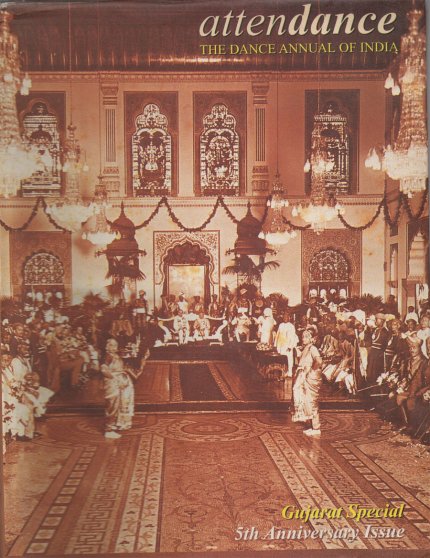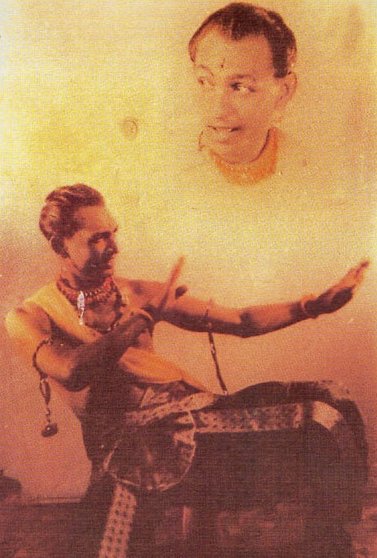
|   |

|   |
Baroda makes Bharatanatyam national - Ashish Mohan Khokar e-mail: khokar1960@gmail.com Rare photos: The Mohan Khokar Dance Collection March 17, 2014 Baroda in Gujarat - a small royal town - bit like Mysore in south India, is the reason Bharatanatyam reached the rest of India. While no single person or event can make historical changes, they become a catalyst and link in that chain. Yes, had it not been for two devadasis who came as "dowry" when a Tanjore princess married the royalty of Baroda, Bharatanatyam would have never reached north and west and rest of India a century ago. Here's how.  Baroda palace dancers  Pt Sundarlal Gangani The story of Baroda's connection with Bharatanatyam begins in 1883, when the young, handsome Maharaja of Baroda, Sayajirao Gaekwad III, married a beautiful princess of Tanjore called Chimnabai. As part of her dowry, the princess brought a troupe of dancers and musicians. In this troupe were two dancers - Gaura, or Gowriammal, whose mother was Kammu Amma, a Tanjore court dancer, and Bhanumathi, a devadasi from Kumbakonam. Two nattuvanars Vadivelu and Sabhapati - father and son - accompanied the dancers. Gaura stayed on but Bhanumati returned to Kumbakonam and another dancer Kanthimati came as her replacement. 
Tanjore nautch
party
Two other palace dancers learnt Bharatanatyam from Gaura. Saraswati who lived in Mumbai, and Ratnamala who lived in Baroda itself. She came to Baroda as a 12 year old. "Our day began with good breakfast, milk with egg, and badam halwa to build stamina. A buggy coach would come from the palace to fetch us for practice." They performed mostly at Motibaug and Nazarbaug palaces, although they practiced daily at Indumati palace. "Every Wednesday we danced at Indumati Palace and when the Maharaja asked for us, we danced at Motibaugh too," recalled Ratnamala to attendance, the yearbook of dance, when it brought out Gujarat Special in 2002. This issue/book remains the only authentic overview and first hand compilation of history of dance in Baroda (and Gujarat) till date. Unlike the mix and fix, match and latch (to other languages) that came to dilute the form, these dancers "presented only traditional margam, no deviation, not even to please the kings! We never composed anything in Marathi or Gujarati to curry favour," Ratnamala is on record. "This 'bastardisation of Bharatanatyam' happened later, when regional and some local talents, without clue to language and our culture, started taking short cuts." Can dhokla taste like dosa? Why should it? What's the point of doing Bharatanatyam in Gujarati or Marathi, even if Tanjore had a Maratha connection? There were a few Kathak dancers at the palace too such as Gaurabala, who came from Mumbai, Chamoo and Sharda. Singers Mirabai and Haridham too stayed at the palace. Gaura amma died in 1940 (by other account in 1941). She was dear to people and the palace of Baroda, so a statue was made of her at the Palace Museum and placed there. Kanthimati died in 1953. Chandra amma, Gaura's daughter died in 1983. By then Bharatanatyam had not only established itself, but entrenched itself in all of India. When Baroda became part of India upon independence, the royalty gifted many buildings to be used as various faculties and departments to become India's first university - the Maharaja Sayajirao University (MSU), initiated in 1949-50 to teach performing and fine arts at graduate level. Today, various departments are spread in various palaces of the city right from the station to the airport. By the only clean lake in the heart of the city - Sursagar - stands the Dept of Performing Arts. Its first head was iconic Mohan Khokar, who came from Madras as Kalakshetra's first male student from north India and he set up the theory and practice of the dance dept. He also invited and engaged traditional nattuvanars like the son of Kanthimati, Kubernath for mridangam and a great Kathak family - the Ganganis, Kundanlal and cousin Sundarlal, for teaching tabla and Kathak. During Mohan Khokar's time such Bharatanatyam stalwarts as E. Krishna Iyer, Dr. Raghavan were invited to lecture too. And for Kathak, Sitara Devi and Damayanti Joshi. That the department has grown over the years teaching dance to locals and outsiders shows its impact and outreach. Nargis Katpitia, a Parsi, was first to enroll. Then came Prerna Desai, Pratibha Pandit, Dhiru Mistry, Elakshi Thakore, Anjani Ambegaonkar, Francis Barboza, Neelima Nimbalkar, Rema Shrikant and second generation teachers and heads like Anjali Mehr and C.V. Chandrasekhar and then the third generation students-turned teachers like Parul Shah, Jagdish Gangani etc. who have willy nilly, kept the dept. of dance alive. As noted in the March editorial of this portal, the dept., looks pretty dead now (as with most things Indian mediocrity and politics have ruined its inner core), yet few good people continue the mission impossible! Every year, Dr. Parul Shah mounts an academic dance festival and seminar, around her mentor late Anjali Mehr's death anniversary in mid Feb. Artistes of renown now come to Baroda to perform and interact with students. Pt. Jagdish Gangani too mounts in the same month, a focus on Kathak. To think this sleepy royal town put Bharatanatyam on the map of India and kept Jaipur Kathak alive... Dance history is made of such snippets.  Ashish Mohan Khokar is a reputed dance critic and historian, with over 40 published books. He edits and publishes India's only yearbook on dance - attendance - in its 16th year now. He has made films, educational programs and discourses on dance that are internationally popular. He is the inheritor-curator of India's largest dance archives and is currently engaged in its organization. He is also India's only exclusive dance books and biography publisher (Ekah). He mentors many young talents and helps mount special academic dance discourses. He Chairs the Dance History Society, which has instituted annual awards in memory of dance greats. For details see attendance-india.com Post your comments Pl provide your name and email id along with your comment. All appropriate comments posted with name and email id in the blog will also be featured in the site. |